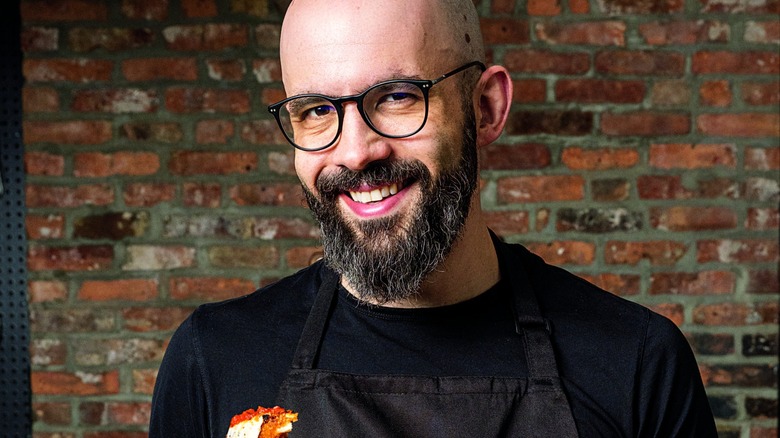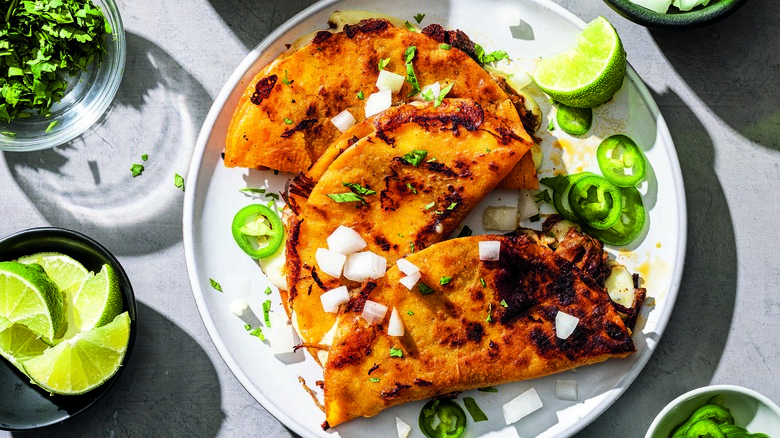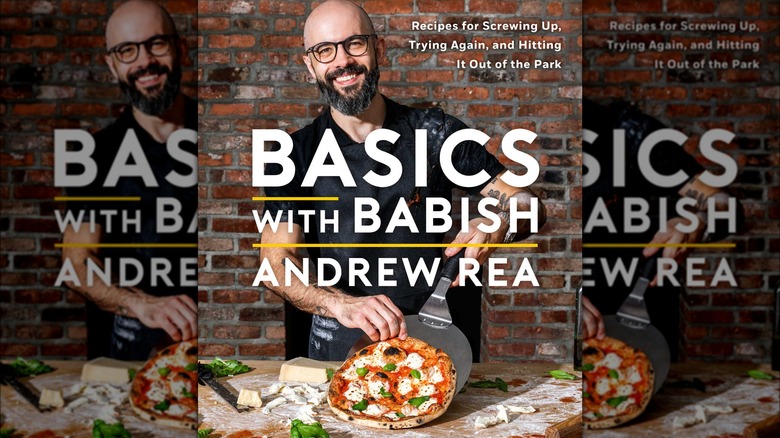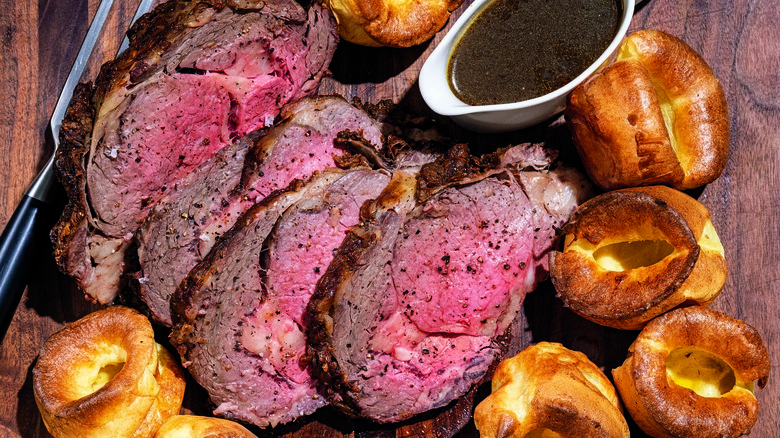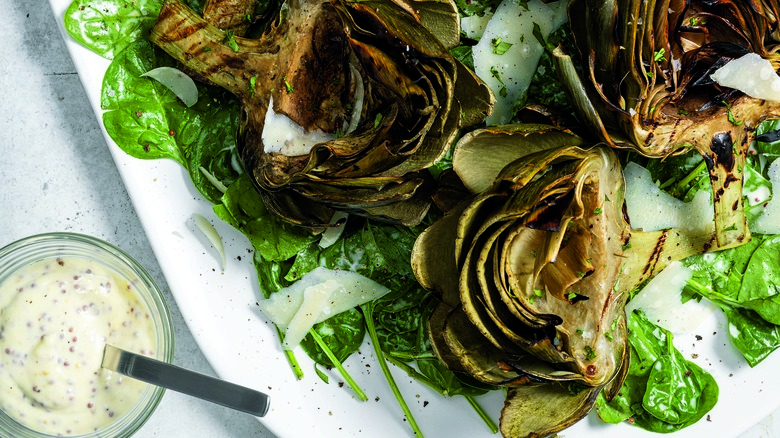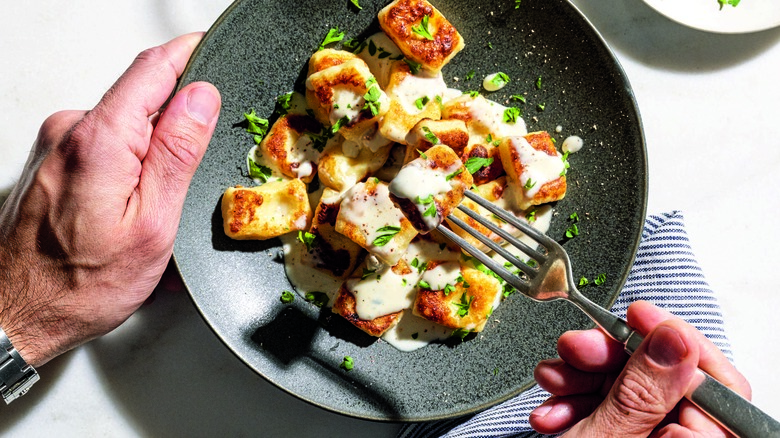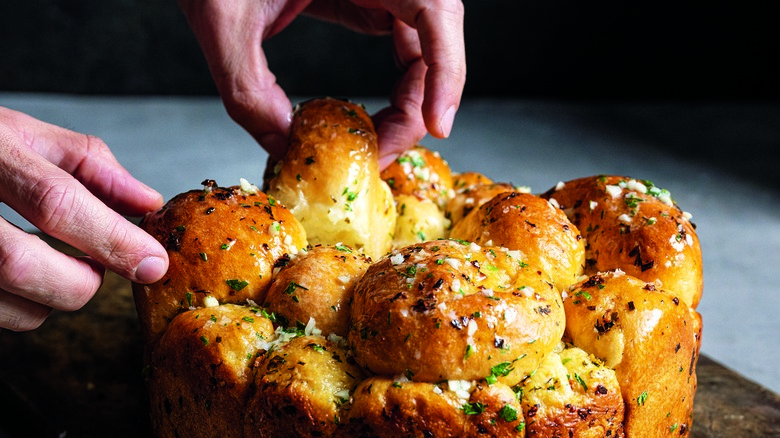Andrew Rea's New Cookbook Is All About Making Mistakes - Exclusive Interview
We may receive a commission on purchases made from links.
Maybe you've followed Andrew Rea throughout his entire career, watching as he grew a YouTube channel dedicated to all things film and TV-inspired cooking into a massive success. Maybe you started watching and following along once Rea's channel grew to include more than just pop culture food favorites, and you caught his "Basics with Babish" series of videos designed to help newbies in the kitchen get their footing. Maybe you've seen his cookware line in Walmart.
Whatever the case may be, if you've only been a casual observer of Rea's adventures in the kitchen thus far, you'll have little excuse to not join in on the fun moving forward, thanks to Rea's new cookbook "Basics with Babish." The cookbook takes a unique approach to teaching beginners — or anyone who wants to level up their skills in the kitchen — by focusing in on mistakes: why you make them, what you learn from them, how you can avoid them in the future, and how they're entirely okay and maybe even expected. In an exclusive interview, we spoke with Rea to learn more about turning his "Basics with Babish" video series into a cookbook, as well as other projects he has coming down the pipeline.
Reclaiming your mistakes
You've already published multiple cookbooks, but those are focused on recreating the TV and movie-inspired dishes that you're known for. With this cookbook, why did you specifically want to focus on beginner-friendly cooking?
I myself am a perpetual beginner. I specifically don't rehearse dishes before I do them on camera so that I can catch my screw-ups. I like to show them as learning experiences, and it's therapeutic for me, as someone who's beaten up on themselves for making mistakes their entire life. It's nice to reclaim [those mistakes] as learning experiences, and it's where the sum total of my cooking knowledge has come from. I haven't gone to culinary school. I haven't trained in any formal capacity. It's all been trial and error my entire life.
I wanted to show burgeoning home chefs that it's not only okay to make mistakes, it's also normal, because in spite of what food media might suggest, it's not very easy to make any dish perfect the first time. I wanted people to not only know that it's okay, but also that it's an opportunity to figure out what went wrong, so next time you can hit it out the park.
One thing I noticed when looking through the cookbook was that, even though it's geared toward beginners, there are still recipes that a lot of beginners would find intimidating, like making homemade bread or pasta. How do you take recipes like that and make them no longer intimidating and more approachable?
The book is aimed at beginners to people who want to step up their game, like people who might be messing around in the kitchen but want to make the best focaccia they've ever made or make eggs Benedict for the first time, which is an extremely intimidating process. There's a mix of those kinds of recipes. There are recipes in the book that I would absolutely not recommend for beginners, and I loudly state that in the headnote and in the information about the recipe.
To make things less intimidating, one of the features of the book that I'm proudest of is that every recipe comes with a description of how I've personally screwed up, because there's not a recipe in that book that I haven't messed up at one point or another, especially the first time making it. By describing in detail how the person who wrote the recipe has messed it up, that makes it more accessible and a little less scary to try for the first timer.
How to write a beginner-friendly cookbook
You've been making beginner-friendly videos for a while. How does it differ, teaching people the basics of cooking via video versus teaching them in a cookbook?
I have ADHD, so reading step-by-step instructions can either be amazing or completely impossible, depending on the context. I wanted to make it as entertaining as possible for people whose attention might wander, and offer different tips, like treating the ingredients list as a to-do list. That's something that I wish I had learned 10 or 20 years ago: to look at the list of ingredients and see it as the first set of instructions before you even hit the instructions. If it says "half an onion, finely minced," you're doing that before you turn on any burners or crank on the oven. If it says "a quarter teaspoon of these three different spices," you're measuring that out before a knife hits a cutting board. Little tips and tricks like that make written recipes a little bit more accessible and a little easier to follow.
Something else that I did to try to make things more accessible to beginners is, every recipe comes with a troubleshooting section. For different kinds of bread, there are different scenarios like, "My loaf turned out short and pale and dense." That's because either your yeast is dead, or the gluten wasn't developed well enough, or that loaf is over-proofed, depending on different factors.
There are tools and tips to make more difficult recipes a little bit more accessible to newcomers, and there are examples that make them feel not as impossible and not as tall of a mountain to climb. In fact, a great example is the pain au chocolat, which is basically a croissant with chocolate in it. A croissant is one of the more difficult things you could possibly attempt in the kitchen, much less without a specific machine designed for laminating bread. I wrote the headnote [for that recipe] in the voice of one's inner monologue, which is usually discouraging — at least mine is, telling me all the reasons why I can't make pain au chocolat and why I shouldn't even try. My hope with that one is to hold up a mirror to the ridiculous, negative self-talk that can prevent you from even trying a recipe.
What does writing a cookbook look like for you, behind the scenes? Do you already have a lot of this content written down somewhere or ready to go due to your YouTube channel, or is it a lot more involved than just compiling existing content?
Luckily, I did have a lot of recipes written down from existing "Basics with Babish" episodes, but lots of them were years old, even ones that were done recently. In retesting the recipes, rewriting and reformatting them, I discovered a lot of shortcomings or things that I wanted to change, based on the knowledge that I've gained over the past few years of making mistake after mistake. Not only did all the rest have to be reformatted for a formal cookbook layout, but I also needed to make lots of revisions to the existing techniques, just because of, again, the mistake-derived skillset I've acquired over the past seven years.
Where to start
If a complete beginner picks up your cookbook, reads through all the introductory guides, and then wants to start with a recipe, where would you tell them to start? What's going to be the most accessible section of the book, or are there any individual recipes that you recommend?
The book is divided by dish or protein. You have pork, beef, pasta, seafood, poultry, eggs, and bread. Pasta is probably the best place to start. Shrimp scampi is one of my favorite dishes. It's elevated by using a great mix of fresh herbs — tarragon, parsley, and marjoram — but it's something that comes together pretty quickly, pretty easily, and really blows any other shrimp scampi out of the water.
[Another] great place to start is the stir-fry. It's an excellent exercise in mise en place, which is, as I described in the book, the fancy-sounding phrase to describe the simple-sounding idea of getting everything in its place before you start. It's the same concept that I was talking about in treating the ingredients list as a to-do list. It's something you really need to do for stir-fry. The whole dish takes maybe three minutes to cook, because you're using very high heat, and you're adding different ingredients after less than a minute of cooking. You have to have everything chopped up, measured, and ready to go before you get started. Granted, that's a little intimidating; there's high heat involved, which for newcomers, can be a lot.
If you're really starting out for the first time in the kitchen, the braised chicken thighs with fennel pasta is a very easy, one-pan weeknight dinner that comes together in a little less than an hour. It's these really tender, braised chicken thighs with super crispy skin and this pasta that's cooked directly in the cooking liquid, so it gets all the great chicken juices and fennel, and all those great flavors soaked up into it, with lots of fresh herbs and butter. It tastes great. It's not horrendously unhealthy. It uses whole wheat pasta, after all. It's something that I made for dinner for myself years ago. I first started making an iteration of this dish 10 years ago. It demonstrates a lot of cooking concepts and it's something that is relatively foolproof. Even if things screw up, if the chicken sticks to the pan a little bit or if the pasta overcooks, it's not going to ruin it. It's another learning experience.
Outfitting your kitchen
If a complete beginner is going to start cooking any of the recipes in the book, would you recommend they pick up any special equipment? Is there any cookware or gear that you'd recommend they stock their kitchen with before they embark on this journey?
Probably the most utilized piece of equipment in this book, and in life in general, is a high walled 12-inch stainless steel sauté pan. It has incredible utility for frying, deep-frying, sautéing, making pasta ... It's perfect for cooking spaghetti. You think of using a spaghetti pot for cooking spaghetti, but the vast majority of the ones that you're going to get in a 12-piece set is going to be too small to fit the spaghetti in horizontally, so it ends up sort of sitting on an angle. You have to slowly push it in. It makes the pasta stick together, it makes it cook unevenly, and sometimes if you're not keeping an eye on it, you can burn the tips of the pasta. It is a pain. With a 12-inch-high wall stainless sauté pan, it's exactly the width that it needs to be, to just drop the spaghetti straight in. Then, you're also cooking it in less water, which makes the water starchier, which makes it better for building sauces. That's an essential piece of equipment.
For most of the bread recipes, you're going to want a stand mixer. There are some no-knead recipes. The concept of lift-and-fold is explored, which is a way to build up gluten without having to destroy your forearms. However, for the most part, if you want to make great or complicated bread, it really helps to have a stand mixer. I know that's a tall order for a beginner cook, but that's the bread section.
It also always helps to have a 12-inch non-stick, or at least an eight-inch non-stick, pan for making scrambled eggs, quesadillas, and certain kinds of pastas.
The top three tools I'd recommend for getting started in this book are the 12-inch-high walled stainless steel sauté pan, and a really good chef's knife that you feel comfortable with, that feels well weighted in your hand, that's good and sharp. These can be bought for not that much money. I don't mean to point to my own cookware line, but we sell some great chef's knives for about $20. They're forged German steel.
Lastly, a big ol' cutting board. Too often, we get those three-packs of cutting boards from Ikea that are 12 inches, eight inches, and six inches. The six-inch one isn't big enough to chop a carrot. Something that can really quickly and easily overwhelm newcomers in the kitchen is having a crowded cutting board and one that's slipping around all over the place. Get a big, heavy cutting board, secure it in place with a damp, clean kitchen towel underneath it that keeps it from slipping around, and a big wide work surface so you don't feel crowded or overwhelmed when you're dealing with a whole bunch of new ingredients.
How to get consistent results in the kitchen
Are there any particular recipes in the cookbook that you personally struggled with the most, in terms of developing a good recipe or method that would consistently produce great results and that you felt confident including in the book?
Unfortunately, consistent results are really dependent upon you as a cook and your equipment as much as they are the recipe. I'm not trying to take heat off myself. It's more that I have baked recipes weighed down to the gram, and I've done them repeatedly back-to-back-to-back and have gotten different results every time.
I put out an episode called "Cinnamon Rolls," which is one of the recipes in this book. I did the exact same recipe three times in a row, on the same day. When you see the rolls come out of the oven, you'll see that some of them are super puffed out and jumping out in all directions, some of them are a little short and stout, and some of them are perfect. It can depend on the humidity in your kitchen, or on the variances in your oven temperature. It can depend on a thousand different factors. This is a concept that I touched on a lot in the book — learning to recognize these factors and work with them. That's how you end up getting consistent results in your own kitchen.
The recipes I was probably most nervous about including the book was the pizza section as a whole. Pizza is a form of bread, so that's complicated enough right there, but also we have distinct regional pizzas: Neapolitan, New York, Chicago. These are pizzas that have extremely distinct form factors and huge, rabid fandoms. I didn't want to betray the original recipes, and I wanted to make recipes that were consistently re-creatable in the home kitchen. The pizza is the big wild card. We'll see how that shakes out.
A homestay with a culinary slant
You also have Bed and Babish opening soon. What can people expect and why was this a project you wanted to take on?
Bed and Babish is opening very soon. It's in the final stages of construction. We're starting to put the appliances in. It's going to be a lovely two-bed, two-bath [vacation rental] overlooking the Delaware River ... in the Catskills. I started ideating it about two years ago when I stayed in a beautiful cabin in upstate New York that was incredible and a wonderful, relaxing place to be — and it had three pans and the dullest knives on the planet, which is a pretty universal experience in vacation rentals. [The rental's kitchen] can be described as a chef's kitchen and they might have a six-burner Viking range with huge custom hood ventilation, but they don't give you the gear that you need to make a proper meal. I'd say that's happened to me 90% of the time in the places that I've stayed, maybe 100%, but I want to give the benefit of the doubt.
I wanted to create a vacation rental that was as beautiful and relaxing as that experience, but with a foodie [focus] to it. We're not only going to have a full suite of fresh, sharp, functional tools, but we're also going to have some a la carte options for having groceries waiting in the fridge; having heat-and-eat meals waiting in the fridge; having local beer, local cheese, things that are reflections of the community, and opportunities for people to grow their culinary skillset or just enjoy some lovely home-cooked meals in the mountains or the woods.
Anything else new?
Those are the biggest things on the docket right now. I'm starting pre-production on a short film that I've been kicking around over the past year. It's about food. It's about appreciation of food and appreciating where it comes from, and the web of people, influence, and resources that go into every bite that you take. I want to illustrate that in an entertaining, less-than-15-minute short. I went to film school. This has always been my dream to produce something like this, and now seems like the best time.
"Basics with Babish" by Andrew Rea is out now wherever books are sold.
This interview has been edited for clarity.
